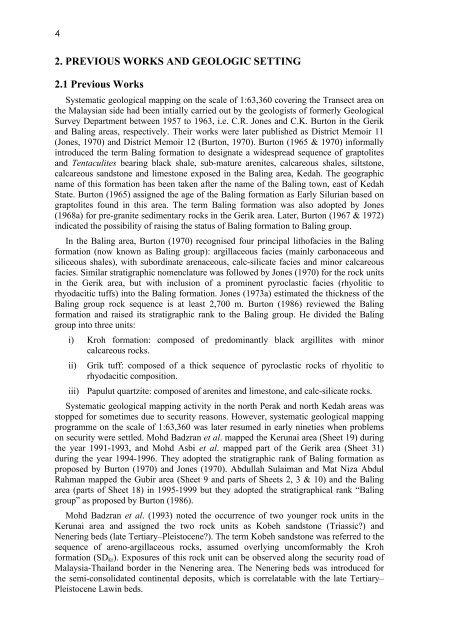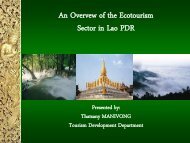GEOLOGY OF THE PENGKALAN HULU-BETONG TRANSECT ...
GEOLOGY OF THE PENGKALAN HULU-BETONG TRANSECT ...
GEOLOGY OF THE PENGKALAN HULU-BETONG TRANSECT ...
Create successful ePaper yourself
Turn your PDF publications into a flip-book with our unique Google optimized e-Paper software.
4<br />
2. PREVIOUS WORKS AND GEOLOGIC SETTING<br />
2.1 Previous Works<br />
Systematic geological mapping on the scale of 1:63,360 covering the Transect area on<br />
the Malaysian side had been intially carried out by the geologists of formerly Geological<br />
Survey Department between 1957 to 1963, i.e. C.R. Jones and C.K. Burton in the Gerik<br />
and Baling areas, respectively. Their works were later published as District Memoir 11<br />
(Jones, 1970) and District Memoir 12 (Burton, 1970). Burton (1965 & 1970) informally<br />
introduced the term Baling formation to designate a widespread sequence of graptolites<br />
and Tentaculites bearing black shale, sub-mature arenites, calcareous shales, siltstone,<br />
calcareous sandstone and limestone exposed in the Baling area, Kedah. The geographic<br />
name of this formation has been taken after the name of the Baling town, east of Kedah<br />
State. Burton (1965) assigned the age of the Baling formation as Early Silurian based on<br />
graptolites found in this area. The term Baling formation was also adopted by Jones<br />
(1968a) for pre-granite sedimentary rocks in the Gerik area. Later, Burton (1967 & 1972)<br />
indicated the possibility of raising the status of Baling formation to Baling group.<br />
In the Baling area, Burton (1970) recognised four principal lithofacies in the Baling<br />
formation (now known as Baling group): argillaceous facies (mainly carbonaceous and<br />
siliceous shales), with subordinate arenaceous, calc-silicate facies and minor calcareous<br />
facies. Similar stratigraphic nomenclature was followed by Jones (1970) for the rock units<br />
in the Gerik area, but with inclusion of a prominent pyroclastic facies (rhyolitic to<br />
rhyodacitic tuffs) into the Baling formation. Jones (1973a) estimated the thickness of the<br />
Baling group rock sequence is at least 2,700 m. Burton (1986) reviewed the Baling<br />
formation and raised its stratigraphic rank to the Baling group. He divided the Baling<br />
group into three units:<br />
i) Kroh formation: composed of predominantly black argillites with minor<br />
calcareous rocks.<br />
ii) Grik tuff: composed of a thick sequence of pyroclastic rocks of rhyolitic to<br />
rhyodacitic composition.<br />
iii) Papulut quartzite: composed of arenites and limestone, and calc-silicate rocks.<br />
Systematic geological mapping activity in the north Perak and north Kedah areas was<br />
stopped for sometimes due to security reasons. However, systematic geological mapping<br />
programme on the scale of 1:63,360 was later resumed in early nineties when problems<br />
on security were settled. Mohd Badzran et al. mapped the Kerunai area (Sheet 19) during<br />
the year 1991-1993, and Mohd Asbi et al. mapped part of the Gerik area (Sheet 31)<br />
during the year 1994-1996. They adopted the stratigraphic rank of Baling formation as<br />
proposed by Burton (1970) and Jones (1970). Abdullah Sulaiman and Mat Niza Abdul<br />
Rahman mapped the Gubir area (Sheet 9 and parts of Sheets 2, 3 & 10) and the Baling<br />
area (parts of Sheet 18) in 1995-1999 but they adopted the stratigraphical rank “Baling<br />
group” as proposed by Burton (1986).<br />
Mohd Badzran et al. (1993) noted the occurrence of two younger rock units in the<br />
Kerunai area and assigned the two rock units as Kobeh sandstone (Triassic?) and<br />
Nenering beds (late Tertiary–Pleistocene?). The term Kobeh sandstone was referred to the<br />
sequence of areno-argillaceous rocks, assumed overlying uncomformably the Kroh<br />
formation (SDkr). Exposures of this rock unit can be observed along the security road of<br />
Malaysia-Thailand border in the Nenering area. The Nenering beds was introduced for<br />
the semi-consolidated continental deposits, which is correlatable with the late Tertiary–<br />
Pleistocene Lawin beds.



